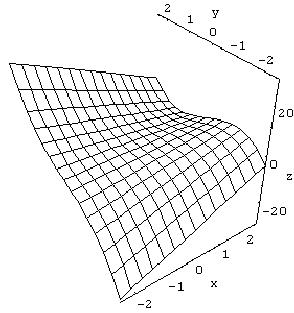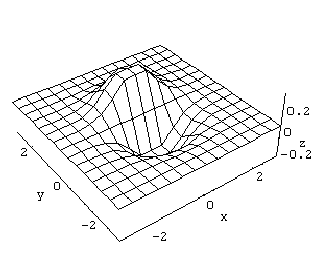2. Write an equation for the plane tangent to the surface z = y3 - 2xy at the point (1, -2).
The idea is that you hold x constant and
take the derivative with y as the variable, but the definition is
fy =![]() .
.
2. Write an equation for the plane tangent to the surface z = y3
- 2xy at the point (1, -2).
 First
we find the two partial derivatives:
First
we find the two partial derivatives:
fx = -2y
fy = 3y2 - 2x
Then we evaluate them at (1, -2):
fx(1, -2) = -2(-2) = 4
fy(1, -2) = 3(-2)2 - 2(1)
= 10
We also need a z coordinate for our point of tangency,
so we plug (1, -2) into our original function:
z0 = (-2)3 - 2(1)(-2) =
-4
And then we pop all these things into the appropriate
slots in the point-slope equation for a plane:
z - z0 = fx(x0,
y0) (x - xo) + fy(x0, y0)
(y - y0)
z + 4 = 4(x-1) + 10(y+2)
We can either leave it like that (since the question
didn't specify a particular form for the answer) or carefully simplify
to something like:
z = 4x + 10y + 12
3. Let f(x,y) = ![]() .
Find the gradient of f at the point (1, -1).
.
Find the gradient of f at the point (1, -1).
 As usual, we first need to find the partial derivatives
with respect to x and y:
As usual, we first need to find the partial derivatives
with respect to x and y:
![]()
![]()
![]()
Then we evaluate each of these at the point (1,
-1):
fx(1, -1) = -2(1)(-1)e-2
= 2e-2
fy(1, -1) = e2 +
-2(-1)2 e-2 = -e-2
And finally we put these together as the x and
y components of the gradient vector:
grad f = <2e-2,-e-2>